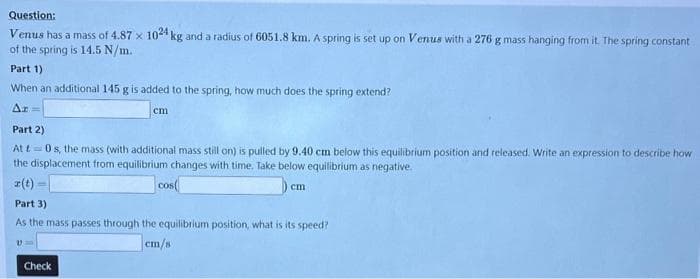Question: Venus has a mass of 4.87 x 1024 kg and a radius of 6051.8 km. A spring is set up on Venus with a 276 g mass hanging from it. The spring constant of the spring is 14.5 N/m. Part 1) When an additional 145 g is added to the spring, how much does the spring extend? Δt = Part 2) Att0s, the mass (with additional mass still on) is pulled by 9.40 cm below this equilibrium position and released. Write an expression to describe how the displacement from equilibrium changes with time. Take below equilibrium as negative. z(t) cos( Part 3) As the mass passes through the equilibrium position, what is its speed? cm/s Check cm cm
Question: Venus has a mass of 4.87 x 1024 kg and a radius of 6051.8 km. A spring is set up on Venus with a 276 g mass hanging from it. The spring constant of the spring is 14.5 N/m. Part 1) When an additional 145 g is added to the spring, how much does the spring extend? Δt = Part 2) Att0s, the mass (with additional mass still on) is pulled by 9.40 cm below this equilibrium position and released. Write an expression to describe how the displacement from equilibrium changes with time. Take below equilibrium as negative. z(t) cos( Part 3) As the mass passes through the equilibrium position, what is its speed? cm/s Check cm cm
Physics for Scientists and Engineers: Foundations and Connections
1st Edition
ISBN:9781133939146
Author:Katz, Debora M.
Publisher:Katz, Debora M.
Chapter7: Gravity
Section: Chapter Questions
Problem 37PQ: The Sun has a mass of approximately 1.99 1030 kg. a. Given that the Earth is on average about 1.50 ...
Related questions
Topic Video
Question

Transcribed Image Text:Question:
Venus has a mass of 4.87 x 1024 kg and a radius of 6051.8 km. A spring is set up on Venus with a 276 g mass hanging from it. The spring constant
of the spring is 14.5 N/m.
Part 1)
When an additional 145 g is added to the spring, how much does the spring extend?
Δt =
cm
Part 2)
Att0s, the mass (with additional mass still on) is pulled by 9.40 cm below this equilibrium position and released. Write an expression to describe how
the displacement from equilibrium changes with time. Take below equilibrium as negative.
z(t)
cos(
Part 3)
As the mass passes through the equilibrium position, what is its speed?
cm/s
Check
cm
Expert Solution
This question has been solved!
Explore an expertly crafted, step-by-step solution for a thorough understanding of key concepts.
This is a popular solution!
Trending now
This is a popular solution!
Step by step
Solved in 2 steps with 2 images

Knowledge Booster
Learn more about
Need a deep-dive on the concept behind this application? Look no further. Learn more about this topic, physics and related others by exploring similar questions and additional content below.Recommended textbooks for you

Physics for Scientists and Engineers: Foundations…
Physics
ISBN:
9781133939146
Author:
Katz, Debora M.
Publisher:
Cengage Learning

Principles of Physics: A Calculus-Based Text
Physics
ISBN:
9781133104261
Author:
Raymond A. Serway, John W. Jewett
Publisher:
Cengage Learning

College Physics
Physics
ISBN:
9781285737027
Author:
Raymond A. Serway, Chris Vuille
Publisher:
Cengage Learning

Physics for Scientists and Engineers: Foundations…
Physics
ISBN:
9781133939146
Author:
Katz, Debora M.
Publisher:
Cengage Learning

Principles of Physics: A Calculus-Based Text
Physics
ISBN:
9781133104261
Author:
Raymond A. Serway, John W. Jewett
Publisher:
Cengage Learning

College Physics
Physics
ISBN:
9781285737027
Author:
Raymond A. Serway, Chris Vuille
Publisher:
Cengage Learning

Physics for Scientists and Engineers
Physics
ISBN:
9781337553278
Author:
Raymond A. Serway, John W. Jewett
Publisher:
Cengage Learning

Physics for Scientists and Engineers with Modern …
Physics
ISBN:
9781337553292
Author:
Raymond A. Serway, John W. Jewett
Publisher:
Cengage Learning

Physics for Scientists and Engineers, Technology …
Physics
ISBN:
9781305116399
Author:
Raymond A. Serway, John W. Jewett
Publisher:
Cengage Learning